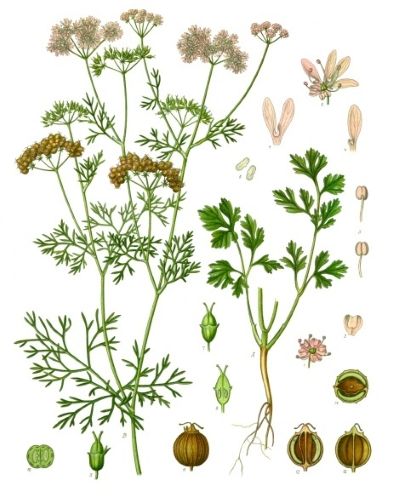Coriander
- Description of Coriander
- Distribution and Ecology of Coriander
- Raw Materials from Coriander
- Chemical Composition of Coriander
- Uses and Benefits of Coriander
- Precautions for Using Coriander
- Contraindications for Using Coriander
- Medicinal Recipes with Coriander
- Cosmetic Uses of Coriander
- Culinary Uses of Coriander
Coriander
Coriandrum sativum L.
Apiaceae Family
Description of Coriander
Coriander is an annual herbaceous plant 30–70 cm tall. Root system taproot, penetrates 20–40 cm deep. Stem erect, thin, branched in upper part, glabrous. Leaves alternate, lower pinnately dissected, petioled, upper sessile, finely divided, 2–5 cm long, bright green. Flowers small, white or pinkish, gathered in compound umbels 3–5 cm diameter. Fruits spherical or oval viscidia, 2–5 mm, brownish-yellow, with characteristic aroma. Flowering June–July, fruiting July–August. Propagated by seeds. Varieties: ‘Yantar’, ‘Debut’, ‘Borodinsky’.
Distribution and Ecology of Coriander
Coriander originates from Mediterranean and Western Asia, cultivated over 3000 years. Grown in temperate and subtropical regions (Russia, India, China, Latin America, Caucasus). Prefers loose, fertile soils (pH 6.0–7.5), well-lit areas with 6–8 hours sunlight. Optimal growth temperature 18–25 °C, withstands short frosts to -5 °C. Greens yield: 1–2 kg/m², seeds: 0.5–1 kg/m². Care: watering (10 L/m² every 5–7 days), nitrogen fertilization (10–15 g/m²), weeding, protection from aphids and umbel moth. Propagated by seeds (sowing April–May). Ecologically enriches soil, used in crop rotation (3–4 years). Not invasive.
Raw Materials from Coriander
Raw materials: leaves (greens), seeds, essential oil, rarely roots. Leaves harvested June–July before flowering, dried in shade at 25–30 °C (yield 10–15%). Seeds collected July–August after ripening, dried at 30–35 °C (yield 20–25%). Essential oil extracted from seeds by steam distillation (yield 0.5–1%). Roots harvested August, dried at 30–35 °C (yield 15–20%). Quality: leaves green, no yellowing, moisture <12%, organic/mineral impurities ≤0.5%, total ash ≤8%; seeds whole, brownish-yellow, essential oil ≥0.5%; oil clear, yellowish. Store leaves and seeds in airtight containers (1–2 years), oil in dark glass vials (2 years). Leaves fresh spicy odor; seeds warm, spicy-citrus; leaves sharp-spicy taste, seeds mild spicy.
Chemical Composition of Coriander
Leaves: water (85–90%), carbohydrates (3–5%), proteins (2–3%), vitamins (C up to 50 mg/100 g, A, K, B1, B2), flavonoids, polyphenols, essential oil (0.1–0.2%, linalool, geraniol), minerals (potassium, calcium, iron). Seeds: essential oil (0.5–1%, linalool 60–80%, pinene, terpinene), fatty oil (15–20%), proteins (10–12%), carbohydrates (20–25%), flavonoids, coumarins. Roots: essential oil (0.1%), flavonoids. Caloric value leaves: 20–25 kcal/100 g, seeds: 300–350 kcal/100 g.
Uses and Benefits of Coriander
Coriander has antiseptic, antispasmodic, carminative, antioxidant and mild sedative effects due to essential oil, flavonoids and vitamins. Leaves used for digestive disorders (flatulence, colic), colds, stress, appetite improvement. Seeds for gastritis, stomach ulcers, flatulence, cholesterol normalization. Essential oil in aromatherapy for stress relief and mood improvement, inhalations for colds. Leaf and seed infusions anti-inflammatory, for stomatitis, skin irritations. In cosmetology leaves and oil improve skin, reduce oiliness, fight acne.
Precautions for Using Coriander
Leaves and seeds in large amounts (>100 g/day leaves, >10 g/day seeds) may cause allergic reactions or stomach upset. Essential oil (>3 ml/day internal, undiluted external) may irritate skin or mucous. Store leaves and seeds at humidity <12% to prevent mold. Give to children under 3 infusions ≤5 ml/day. Those allergic to Apiaceae start with small doses. Do not combine with blood clotting medications without doctor consultation. Avoid oil on sensitive skin without dilution.
Contraindications for Using Coriander
Contraindicated in allergy to Apiaceae, peptic ulcer exacerbation, pancreatitis, thrombophlebitis, pregnancy, lactation, children under 1. External essential oil or infusions prohibited in eczema, psoriasis or open wounds.
Medicinal Recipes with Coriander
- Seed infusion for flatulence. Infuse 5 g seeds in 200 ml boiling water 30 min, drink 50 ml twice daily for 7 days.
- Leaf infusion for stomatitis. Infuse 10 g leaves in 200 ml boiling water 20 min, rinse mouth 3 times daily for 5 days.
- Inhalation for cold. Add 3 drops essential oil to 1 L hot water, breathe steam 10 min once daily for 5 days.
- Root decoction for colic. Boil 10 g roots in 200 ml water 5 min, drink 50 ml twice daily for 7 days.
- Leaf infusion for skin. Infuse 15 g leaves in 200 ml boiling water 30 min, wipe skin twice daily for 7 days.
Cosmetic Uses of Coriander
Leaves, seeds and essential oil used in cosmetology for antiseptic, antioxidant and anti-inflammatory properties, improve skin and hair.
- Face mask. Grind 20 g fresh leaves, mix with 10 ml yogurt, apply to face 15 min, rinse. Use once weekly.
- Skin toner. Wipe face with 50 ml leaf infusion (10 g in 200 ml water, 20 min) once daily for 7 days.
- Body scrub. Mix 10 g ground seeds with 10 ml coconut oil, massage skin 5 min, rinse. Use once weekly.
- Hair massage oil. Mix 3 ml coriander essential oil with 20 ml almond oil, apply to roots, rinse after 20 min once weekly.
Culinary Uses of Coriander
Leaves used fresh in salads, sauces, soups, meat dishes. Seeds in baking, marinades, curries. Store fresh leaves at 0–5 °C up to 2 weeks, seeds airtight up to 3 years. Varieties: ‘Yantar’ (greens), ‘Borodinsky’ (seeds).
- Coriander pesto sauce. Grind 50 g leaves with 20 g nuts, 20 ml olive oil, 10 g cheese, serve with pasta.
- Marinade with seeds. Mix 5 g seeds with 200 ml vinegar, 10 g salt, 10 g sugar, infuse 24 h, use for meat.
- Salad with coriander. Mix 30 g leaves with 100 g tomatoes, 50 g cucumbers, 10 ml lemon juice, salt.
- Coriander seed tea. Infuse 3 g seeds in 200 ml boiling water 10 min, add honey, serve warm.
Other Properties of Coriander
Used as ornamental in gardens. Seeds and essential oil in perfumery and pharmaceuticals (antimicrobial). Attracts pollinators, natural insect repellent.




